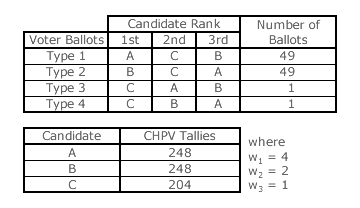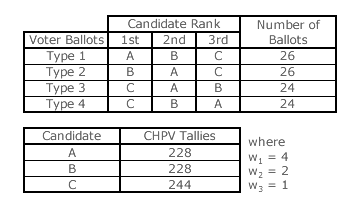Evaluations: General Criteria 4
Pairwise Criteria
When there is a straightforward choice between just two candidates or alternatives, all fair voting systems reduce to the simple declaration of the more popular one as the winner. The Marquis de Condorcet extended this simple principle and employed sets of straightforward pairwise comparisons for elections involving more than two alternatives. For more information on Condorcet methods of voting see the voting system section of Wikipedia or another reference source. GV and CHPV are positional voting systems and are clearly not pairwise comparison methods. Therefore, GV and CHPV do not seek to satisfy pairwise criteria such as the two prominent ones described below.
Condorcet Winner Criterion

If, for every voter, one particular candidate is preferred to every other alternative in a pairwise comparison then that candidate is called the Condorcet Winner. To satisfy the Condorcet Winner criterion this candidate (whenever there is one) must always win the election.
In the three-candidate example shown opposite, 100 voters cast their ranked ballots as one of just four types (as listed). The 49 type 1 voters prefer A to C but the other 51 prefer C to A. Hence, C beats A by 51 votes to 49 in the pairwise comparison.
Similarly, the 49 type 2 voters prefer B to C but the other 51 prefer C to B. Here, C beats B by the same two-vote margin in this pairwise comparison. As C beats all the other (two) candidates in the pairwise comparisons, there is a Condorcet Winner in this election and it is candidate C.
If these same 100 ranked ballots are cast in a CHPV election instead (with the first preference weighted as 4, the second preference as 2 and the third as 1), then the Condorcet Winner C would not only fail to win but would also come last with a tally of just 204; see above table. Indeed, with any valid common ratio (0 ≤ r < 1), there are always similar cases where the Condorcet Winner fails to win in a GV election.
- GV/CHPV makes no attempt to satisfy the Condorcet Winner criterion.
To qualify as a Condorcet method, a voting system must satisfy the Condorcet Winner criterion.
Hence, GV/CHPV systems are not Condorcet methods.
Condorcet Loser Criterion

If, for every voter, one particular candidate is never preferred to any other alternative in a pairwise comparison then that candidate is called the Condorcet Loser. To satisfy the Condorcet Loser criterion this candidate (whenever there is one) must always lose the election.
In the three-candidate example shown opposite, 100 voters cast their ranked ballots as one of just four types (as listed). The 52 type 1 and 2 voters prefer A to C but the other 48 prefer C to A. Hence, A beats C in the pairwise comparison.
Similarly, the same 52 type 1 and 2 voters prefer B to C but the other 48 prefer C to B. Here, B beats C in this pairwise comparison. As C loses to all the other (two) candidates in the pairwise comparisons, there is a Condorcet Loser in this election and it is candidate C.
If these same 100 ranked ballots are cast in a CHPV election instead (with the preferences again weighted as 4, 2 and 1), then the Condorcet Loser C would not only fail to come last but would actually win the election with a tally of 244; see table above. Indeed, with any valid common ratio (0 ≤ r < 1), there are always similar cases where the Condorcet Loser is ranked first in a GV election.
- GV/CHPV makes no attempt to satisfy the Condorcet Loser criterion.
Proceed to next section > Evaluations: Majority Criteria
Return to previous page > Evaluations: General Criteria 3
